Note: If an image ever fails to appear - refresh your page, it really is there
Historical Flags of Mexico
| Flags of New Spain | Flags of the Mexican War of Independence | Flags of Mexico Since 1821 |
Flags of New Spain
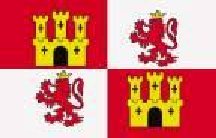
Spanish Royal Standard
|
Spanish Royal Standard 1542
The Spanish Royal Standard was the official flag of the King of Spain. While the Banner of Arms was the ceremonial ensign of the monarch, the Royal Standard or Royal Flag was the ensign design for common use by Spanish ships and military fortification.
Not truly having an official Spanish National flag, many early explorers, including Christopher Columbus, used the Spanish Royal Standard to represent the King and Queen of Spain. There are today many variations manufactured of this royal standard, one of which is shown here.
|
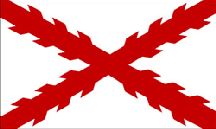
Cross of Burgundy
|
Cross of Burgundy Flag 1506-1843
The Cross of Burgundy Flag, introduced in the reign of Charles I of Spain (Holy Roman Emperor Charles V), was used by Spain between 1506-1701 as a naval ensign, and until 1843 as a land military flag. It was the flag carried by most of the Conquistadors in their exploration and conquest of the New World during this period of time. It represents the cross on which Saint Andrew was crucified.
Although Nueva España (New Spain) never actually had a flag of its own, this standard was used to represent army groups, army headquarters, or commanders of such groups (captain-generals, etc.) in the area after Cortez's conquest of Mexico. |
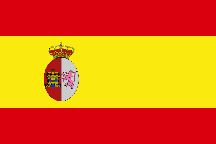
Spanish National Ensign
|
The Spanish War and Merchant Ensign 1785-1931
For three centuries, Mexico was colonized by Spain, during which time almost all of the Mexica nahuatl-origin population living in the basin of Texcoco Lake, died off. Formal independence from Spain was recognized in 1821.
The newly created Spanish War and Merchant Flag replaced the flags used in New Spain in 1785 and was used until the end of Spanish rule in 1822. The flag was originally chosen by Charles III in 1785 for use in the colonies as a naval and coastal fortifications flag.
|
| Flags of New Spain | Flags of the Mexican War of Independence | Flags of Mexico Since 1821 |
Flags of the Mexican War of Independence
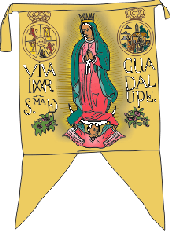
Father Hidalgo's Flag
|
The Standard of Virgin of Guadalupe 1810
An obscure country padre named Miguel Gregorio Antonio Ignacio Hidalgo y Costilla y Gallaga Mondarte Villaseñor became a revolutionary leader sworn to the cause of Mexican independence when at an early Sunday Mass he made an impassioned call to arms against Spanish rule. Father Hidalgo then, so legend has it, buckled on a sword and became leader of the first unsuccessful attempt gain Mexican independence.
This banner was used by Father Hidalgo in the revolution of 1810. It was taken from a Franciscan church and was one of the many banners used by his followers. According to legend, the royalist forces adopted the Virgin of the Remedios for their banner and gave it the rank of Field Marshall, to belittle Hidalgo's standard.
Father Hidalgo and most of his rebel leaders were captured or killed by the royal forces. He was tried and executed in 1811.
|
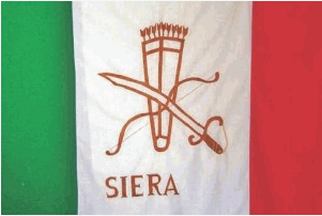
The Siera Flag
(Province of Puebla Battalion Flag?)
|
The Sierra de Zongolica Flag c1812
It is said that the Siera Flag, which is currently housed in the Chapultepec National Museum of History, dates back to 1812, but no legitimate documentation to the claim exist. The traditional account of the flag is that the natives in Sierra de Zongolica (Vera Cruz), led by the Priest Juan Moctezuma y Cortéz, rose in rebellion against the Spaniards. The colors of this flag correspond with the plumage of the local
freedom-loving cuautototl bird, which is very difficult to catch and would rather die than live in captivity.
Today, some enthusiast claim it was precursor of the first Mexican National Flag, but in all probability the flag was originally all white, with its maroon colored quiver-bow-machete emblem in the middle, since most of the flags flown by the Insurgentes were either of white and blue design, or had religious related emblems (see Father Hidalgo's Flag). The stripes were in all probability added to the design after Mexico achieved independence, and this particular flag may have actually been a battalion flag used later in the Province of Puebla. |
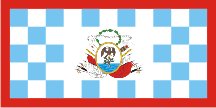
Insurgents War Flag 1813

Insurgents War Flag (variant)
|
The Insurgents War Flag and Ensign c1813-1815, 1821
When the first leader of the Mexican War of Independence, Father Hidalgo was executed, leadership fell to another priest named José María Morelos y Pavón in 1813. He fled south to Puruarán (in the current State of Michoacán), where he summoned a "Supreme Congress" (The Congress of Chilpancingo) in 1813. One of the things this revolutionary congress did, besides naming Morelos generalissimo with the powers of chief executive, was to adopted three flags and a coat of arms for the insurgents.
This is one of those adopted flags and is now called the Bandera de los Insurgentes or Insurgent's Flag. White and blue are colors used by tradition. In Mexico, they have been used since early colonial times in religious festivities. White-blue flags charged with either a depiction of Virgin Mary or that of the eagle and snake were flown by the very first rebels led by Hidalgo back to September 1810. Such battle flags were plain white, white bordered blue, blue with white squares patched in the middle, white bordered with blue and white squares, or checkered blue and white. All of them featured an emblem in the middle, mainly the eagle in one side and the Virgin Mary in the reverse one.
The other two flags approved by the Supreme Congress of the Insurgents in their "Puruarán Decree" were called the "Insurgent's White Flag" and the "Insurgent's Merchant Ensign." (both shown below)
|
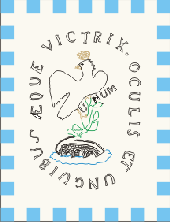
Morelos' Battle Flag
|
José María Morelos' Battle Flag c1813-1815
José María Morelos became the greatest of the insurgent military commanders and for a time had under his control most of Mexico south of Mexico City. However, a succession of military disasters beginning at Valladolid late in 1813 brought a decline in Morelos's prestige and power, and in November of 1815, he was captured and brought to Mexico City in chains.
This flag was used by Morelos´ forces at Valladolid (present-day Morelia) in 1813, and was later captured by royalist troops in 1814 at Tacámbaro. The motto "OCULIS ET UNGUIBUS AEQUE VICTRIX" on Morelos' flag means "By her eyes and claws equally victorious."
In 1815, The Inquisition had Morelos striped of his priesthood for heresy, and later a civil court sentenced him to be executed for treason. |

Insurgent's White Flag
|
Insurgent's White Flag c1813-1815
Late in 1813, the forces of Generalissimo don José María Morelos y Pavón were routed at Valladolid (later named Morelia in his honor) by the royalist forces of Agustín de Iturbide and defeated.
José Morelos in July of 1815 standardized a flag whose basic design had been in used since 1810. The fourth paragraph of the "Puruarán Decree," made by the "Supreme Congress" of Chilpancingo in 1813, describes the "White flag and Ensign" as a white flag, bordered by a six-inch wide sky-blue border, with an olive branch crossing a sword placed in the center of the flag. They were united at their intersection by a laurel crown.
|

Flag and Ensign of Commerce
|
The Insurgent's Merchant Ensign 1813-1815
The third flag mentioned in the "Puruarán Decree" was a merchants flag for use by peaceful merchant ships (i.e. not warships) sailing for Mexico along the coasts of the Gulf between Mexico and North America.
Either this flag or the Insurgent's War Ensign was probably the flag recognized and saluted in New Orleans with a 19 cannon salute in 1815.
|

Fictitious Flag
|
The "New Orleans" Insurgentes Naval Flag 1815 (Fictitious)
One tradition says this flag was recognized by the United States government as the new naval flag of Mexico. According to legend this white-blue-red tricolored flag was used by Mexican insurgent ships in the Gulf and was officially recognized by the United-States when it received a 19 cannon salute entering the American harbor of New Orleans.
Mexican flag historians call this version of the flag simply a fiction and say that the actual flag saluted was either the Insurgents War Flag and Ensign of 1813 or the Insurgents Flag of Commerce of 1813 (both shown above).
|
| Flags of New Spain | Flags of the Mexican War of Independence | Flags of Mexico Since 1821 |
Flags of Mexico Since 1821
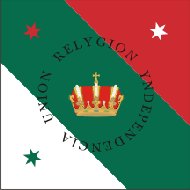
Mexican Flag of 1821
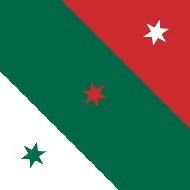
modern variant
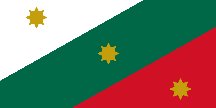
With 8 pointed Stars
Fictitious "Solis" variant
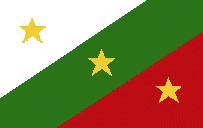
With 5 pointed Stars
Fictitious "Sala de Banderas" variant |
The Flag of the Three Guarantees 1821-1824
When the Mexican War of Independence broke out in 1810, Agustín de Iturbide rejected an offer to lead insurgent troops, choosing to fight on the royalist side. In 1820, when the Spanish king accepted the Cadiz Constitution and its republican ideals, it caused the Mexican landed class, which included Iturbide, to "switched sides" and fight for Mexico's independence from Spain. They saw it as a way to preserve their status and the colonial system.
Iturbide build a coalition of partners that for almost ten years had been fighting one another. Iturbide's promise of the "three guarantees;" independence, supremacy of the Catholic faith and equality of the Creole and Spanish-born classes, allowed him to build the coalition that in 1821 decisively ending the War of Independence. When the new Mexican government was unable to find a suitable royal to take the throne, Iturbide himself was crowned emperor in 1822
According to legend, when the Plan de Iguala was proclaimed in 1821, the first national flag was made by the tailor Jose Magdaleno Ocampo at the request of Agustín de Iturbide with the following specifications: three diagonal stripes, red with a white star, green with a red star and white with a green star. The middle stripe carried an imperial golden crown and the words Religión, Independencia y Unión. White stood for religion, green for independence and red for Mexican unity. It was called the "flag of the three guarantees."
There are many modern variants of this flag. Some versions of this flag will sometimes reverse the direction and order of the stripes, but green is always in the middle. There also are different size and shaped flags available, and the color of the stars are sometimes mistakenly shown as all gold. Even the size and type of star used varies between 5-pointed, 6-pointed or 8-pointed stars. The original flags were, of course, hand made and no two were exactly alike, but all legitimate variants discovered always have a crown in the middle and the stars in proper color on the proper stripes. The most authentic version of this flag shown here is the "Mexican Flag of 1821."
If you wish to cause an argument among Mexican flag experts, call the La Bandera de los Tres Garantias, the first de facto national flag of Mexico, which some consider it to be. The flag was, however, never an official national one, but represented the Ejército Imperial de las Tres Garantías (Imperial Army of the Three Guarantees). The Three Guarantees flag was in use between 1821 and 1824 until Agustín de Iturbide was deposed as Emperor of Mexico and the liberal Constitution of 1824 was implemented. |
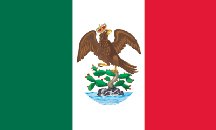
First Mexican Empire Flag
(Official)
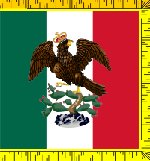
Military Flag 1821
|
The First Mexican National Flag 1821-1823
This flag was used from 1821-1823 during the First Mexican Empire of Agustín de Iturbide. The flag was a green-white-red vertical tricolor with a crowned eagle standing of a nopal raised out from a stone in the middle of the lake. While similar to the national flag that is used today, the eagle in these arms is not holding a serpent in his talons and a crown has been affixed to the head of the eagle to signify the Empire. This basic design was destined to remain the same until the present day, with only nine "official" changes to the design of the coat-of-arms centered on the white stripe. ( For more information about the coat-of-arms on this flag - click here )
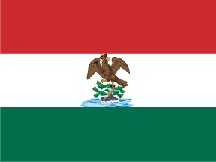
Proposed Flag 1821
During this time, the colored stripes were used in several different orders and directions, until the Junta Provisional Gubernativa decided that the stripes should be vertically green, white and red. Of course, there also existed several unofficial variants of this flag with different coat of arms depictions, specially the eagle. A naval flag had the tricolor pattern, but only contained the eagle with the crown above its head. The army used a similar, square flag, but the eagle was larger than on the national flag. |
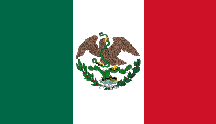
First Mexican Republic Flag
1823 Reestablished 1867
(Official)
|
The Second Mexican National Flag 1823-1863, 1867-1968
Used from 1823-1864 during the establishment of the Mexican Republic.
The second national flag was adopted around the same time as the establishment of the first federal republic in 1823. The only difference the new flag had was in the appearance of the central emblem. The crown was removed from the eagle's head and a serpent was placed in the eagle's right talon. Another addition to the flag is a branch of oak and laurel branches, a tradition which is carried over to the current flag.
This flag was discontinued briefly in 1864 upon the dissolution of the federal republic. It was readopted from 1867–1881 during the reestablishment of the Mexican Republic.
Interestingly, according to the renown Mexican flag scholar Juan Manuel Gabino Villascán, since all the decrees, laws and rules related to the national flag and coat-of-arms never abrogated this original decree of 1823, but just added to it, that from 1823 to 1968 (discounting the Second Empire Flag), there was only really one "official" national flag, and this was it. ( For more information about the coat-of-arms on this flag - click here |
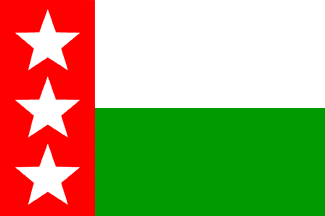
Rio Grande Republic Flag
|
Republic of the Rio Grande 1840
In 1840 a group of insurgents known as the Federalistes (Federalists) declared an independent nation in the Mexican States of Coahuila, Nuevo Leon and Tamulipas. Calling themselves the República de Río Grande they declared Laredo their capitol. They named Jesús de Cárdenas their president and Antonio Canales the Commander-in-Chief of their army. The Mexican Government responded by sending Federal troops under Mexican General Mariano Arista to put down the rebellion.
The two forces met in March of 1840 at the Battle of Morales, where Canales's forces where soundly defeated. General Canales and his remaining troops sought refuge and assistance in Texas, but failed to get any official support. A small force of about 100 Texans volunteers did briefly cross the border, but were driven back into Texas by Mexican forces. In November the Mexican government offered General Canales a position as Brigadier General in the Mexican army if he would abandon the cause; he did and the rebellion collapsed. The whole revolution lasted from January 17 to November 6, 1840. |
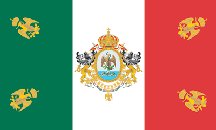
Second Mexican Empire Flag
(Official)
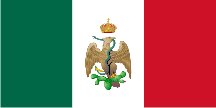
Imperial War Ensign
|
The Third Mexican National Flag 1864-1867
Used from 1864-1867 during the Second Mexican Empire of Maximilian I, the third official national flag used the green, white and red tricolor pattern with the white stripe being charged with the national arms. However, the ratio of the flag was changed from 4:7 to 1:2 and four eagles, which had crowns above their heads, were placed at each corner of the flag. The design, which was ordered by the Emperor Maximilian, gave the arms a look similar to the French Imperial arms, but he decided to add a bit of "Mexican flavor" to the flag.
The flag was abandoned in 1867 when Maximilian was overthrown by Benito Juarez and executed by the Mexican people. The second national flag was adopted once again as the national flag, but it was not officially declared as such. ( For more information about the coat-of-arms on this flag - click here )
Imperial War Ensign and Civil flag 1864-1867
A simplified version of the imperial national flag was also in use by the military, and reportably by non-military civilian govermental organizations. |
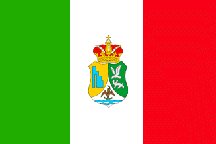
Montezuma Imperial Flag 1849
|
Montezuma (Moctezuma) Imperial Family Flag 1849
Two Spanish families claim to be descendants of the Aztec Emperor Montezuma today. In 1531, Aztec Prince Tehualicahualzin, baptized Pedro, renounced his claim to the empire in exchange for economic compensation and the Spanish title of the "Count of Montezuma." This title was officially recognized on 1627, when his great grandson Pedro Tesifón de Moctezuma received the title. In 1865, the 13th Count of Montezuma was upgraded to the rank of "Duke of Montezuma." This family title is still recognized by the Spanish authorities.
According to another story, in 1466, Xipaguazin (baptized Maria), sister of Tohualicahualzin, married a Catalan lord named Joan de Grau, baró de Toloriu, and when her brother advocated, inherited the Montezuma imperial title. Since that time the line of Grau-Moctezuma (Joan I, Antoni I, Nicolau I, Joan II, Joan III, Jaume I, Jaume II, Magí I, Magí II, Guillem I, Guillem II, Guillem III and his descents) have claimed their "imperial" connection. However, this family's claim to the Aztec crown has not been recognized by either the Spanish or Mexican governments. In 1968, according to one source, the United States Department of Justice granted to Guillem the condition of exiled sovereign and an embassy was briefly opened in Bel Air, Texas (unverified) and another in Paris, France. (unverified) To further cloud this issue, one member of the Grau-Moctezuma family is now claiming to be Grant Master of a group of Spanish Templars and selling titles in the order to anyone willing to pay.
The Grau-Moctezuma Imperial flag was green until 1849, when Magí II adopted a new flag with the Mexican colors bearing the shield of the Grau-Moctezuma. ( click here to see documentation ) They claim the native title of "Vei-Tlaotani of Anahuac" meaning "Lord of the lords of Anahuac." The home of these interesting "imperial descendants" of Montezuma is in Catalonia, Spain. |
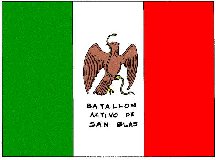
San Blas Battalion Flag
Battle of Chapultepec
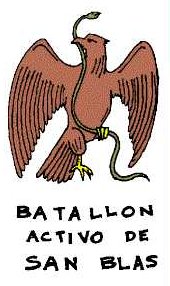
Closeup of coat-of-arms
|
The San Blas Active Coastguard Battalion Flag 1823
The San Blas Battalion was a Mexican infantry unit founded in 1823 in San Blas, hence its name. It most famous action was in the Mexican-American War. The battalion participated in the Battle of Chapultepec, where commanded by Lt. Colonel Felipe Santiago Xicoténcatl, it aided in the defense of the Military Academy in the Chapultepec Castle. Of the 300 men comprising the battalion, only a few survived the tragic battle against the American forces. ( To see more Mexican-American War Era Flags used in Texas and California - Click here )
It is said that Colonel Xicoténcatl, severely wounded, wrapped himself with the Bandera del Batallón de San Blas and died beside his men. This flag is displayed in the Museo Nacional de Historia (National Museum of History) located in the Chapultepec Castle. An inscription below it reads:
"The Defense of the Chapultepec Castle was under the responsibility of General Nicolás Bravo, who, at the head of 200 cadets of the Military Academy and 300 Soldiers of the San Blas battalion, tried to stop the invaders in the woods. Annihilated the San Blas Battalion, the Americans pushed on the western and southern wings of the Castle, where they were stopped for some hours by the cadets, even though later Quitman and Pilow's divisions managed to reach the castle at the cost of many casualties."
It was at this battle that six Mexican military cadets refused to fall back when General Bravo finally ordered retreat and instead fought to the death against the superior American forces. One by one they fell and when only cadet Juan Escutia was left, he grabbed the Mexican flag, wrapped it around himself and jumped off the castle wall.
It is said that his bravery was such, that the American commander saluted the body of Escutia still wrapped in the Mexican flag. |
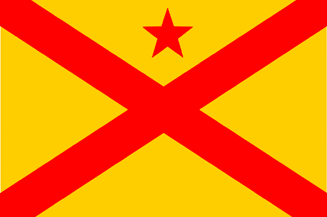
Republic of North Mexico
(existence questionable)
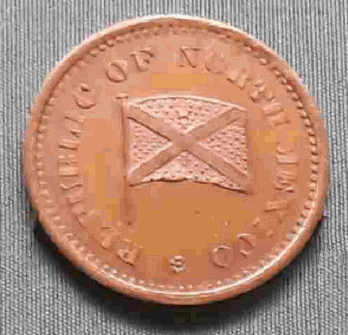
Found on this political message coin dated 1890
|
Republic of North Mexico 1890
This flag is based on a drawing found on a coin most likely created by a Mexican political group named the Federalist in the 1880s. There is no evidence that any actual attempt was made to establish a new "Republic of North Mexico," and it appears to be simply the brain child of this hopeful Mexican political group which was in opposition to Porfitio Díaz's government during the period of 1886-1890. Establishing a Republic of North Mexico was, of course, an unrealistic concept that never came to fruition, though apparently a flag was designed and some coinage produced.
There was even mention of this planned Republic of North Mexico in an article written in The New Yorker in 1839. The article referenced an earlier piece in the Mexican newspaper Cosmopolita where it was claimed that a group of "Texans" were scheming to support the Federalist party in Mexico and to encourage the northern most Mexican states to rebel and establish an independent republic. It would comprise the departments of Tamaulipas, Racatecas, Durango, Sinalos, Señora Nuevo Leon, Coahuila, Nuevo Mexico, and the Californias. The article called to the Mexican government for a new military expedition against the "criminal adventurers" and "usurpers of Texas."
According to Mexican historians Roberto Calleja and Luis Hayas, the bronze two centavos piece was created with no official sanction. On the reverse side of the coin was an inscription in English saying "In God We Trust" and "2 cents 1890" indicating North American origins. It is doubtful the flag depicted on this coin ever existed. |
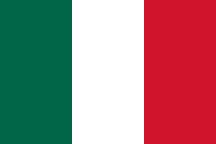
Merchant Ensign
|
The Mexican Merchant Ensign 1864-1865, 1897-1968
This distinctive merchant flag was adopted in 1864. It was used by all non-military ships of Mexican origin, and occasionally also saw some limited, but unofficial use on land.
In 1968, this plain tricolor flag that Mexico had used as its merchant ensign for the last 100 years was legally abandoned and replaced by the current national flag. |
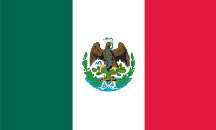
Mexican Flag of 1881-1898
(Official variant)
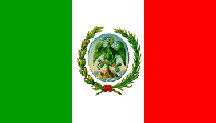
Variant used between
1881-1917
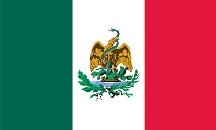
Mexican Flag of 1899-1916
(Official variant)
|
The Evolution of the Mexican National Flag 1881-1968
The present version of the Mexican National Flag is an adaptation of these designs, where the eagle was changed from a front-facing to a side-facing position. Because of the lack of clarity on the legislation regarding different national symbols, such as the national coat of arms, there were many interpretations, and all was left to artistic interpretation. Several governments tried to unify the criteria about the arms' design through decrees, laws and rules, but in the process failed to abrogated the original decree of 1823, just adding to it. Despite government efforts to unify the design: eagle, nopal, stone and lagoon, were all drawn, painted, embroidered after the artists imagination. Those "official" attempts all eventually reached a certain kind of uniformity, and the one of 1934 finally achieved the goal of being the only version universally known throughout the country and abroad.
The first flag shown on the left was the first national "variant" flag used after the Republic Restoration between 1881-1898. ( For more information about the coat-of-arms on this flag - click here ) The second national "variant" flag also shown on the left was used during the last part of Porfirio Díaz's government and Revolution between 1899-1916. ( For more information about the coat-of-arms on this flag - click here )
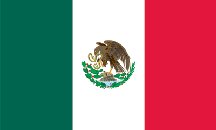 |
|
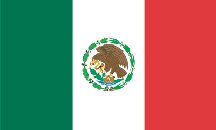 |
Mexican Flag of 1917-1934
(Official variant) |
|
Mexican National Flag 1934-1964
(Official variant) |
The third "variant" national flag (shown directly above) was used from 1917-1934, and originally approved by presidential decree in 1916 by Venustiano Carranza. ( For more information about the coat-of-arms on this flag - click here ) The last "variant" national flag (also shown above) was used from 1934-1968, with the new Coat of Arms designed by Jorge Enciso. Eventually, it became the most universally accepted and known of the "official variant" flags. ( For more information about the coat-of-arms on this flag - click here ) |
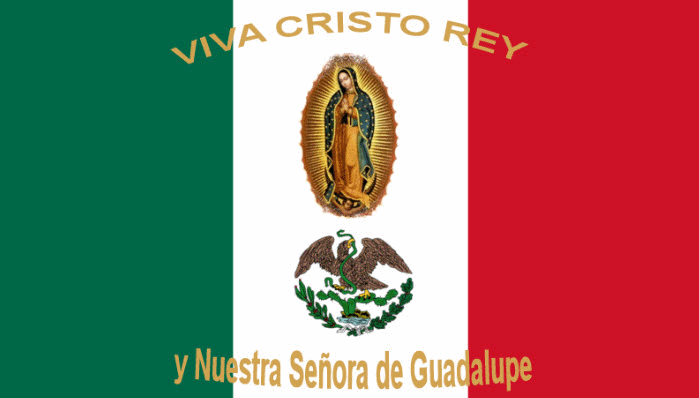
Cristero Flag
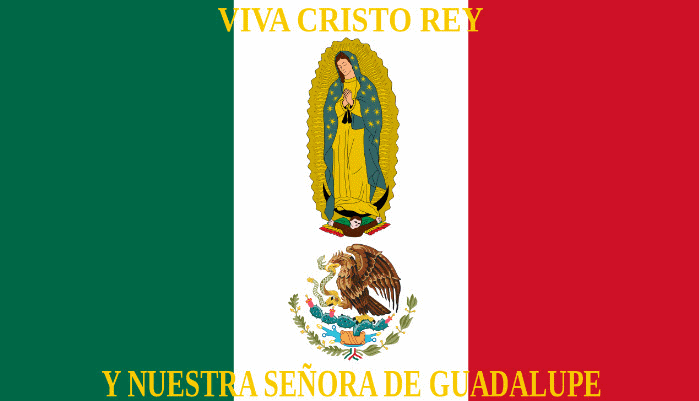
Cristero Flag (Variant)
|
The Cristero Rebellion Flag 1926-1929
The Cristero War (La Cristiada) was a short 4 year violent counter-revolution between 1926 and 1929 against the anti-clericalism of the then ruling Mexican government. The rebellion began when Mexican President Plutarco Calles tried to enforce the anti-clerical statutes of the Mexican Constitution of 1917 in order to lessen the influence of the Roman Catholic Church over the secular government.
Centered in western Mexico, the revolution became one of the larger rebellions in Mexican history. It was tied into the peasants' overwhelming frustration for land and for social justice. The Calles' administration felt threatened by the Church and in 1919 began a 10-year persecution of Catholics, resulting in the death of thousands. After a period of peaceful resistance by Mexican Catholics, armed resistance began in 1927.
The rebels called themselves Cristeros, invoking the name of Jesus Christ the King (Cristo Rey) and with the assistance of women who smuggling guns and ammunition into them eventual attracted the attention the United States Ambassador to Mexico and the financial relief and assistance by the Knights of Columbus. The rebellion was eventually ended by American diplomatic help. Later several priests who were tortured and murdered in public were later canonized by Pope John Paul II. |

Present Day National Flag
The Fourth National Flag
(Official)

Size/color differences between
Italian and Mexican Flag
|
The Fourth Mexican National Flag 1968
The Flag of the United Mexican States or Mexico has been a vertical tricolor of green, white, and red with the national coat of arms charged in the center of the white stripe since 1821. While the meaning of the colors has changed over time, these three colors were adopted by Mexico following independence from Spain during the country's War of Independence. The current version of the flag was adopted in 1968.
The current version uses the design approved by presidential decree in 1916 by Venustiano Carranza, where the eagle was changed from a front-facing to a side-facing position. Flag Historian Juan Manuel Gabino Villascán points out a very important detail about this flag, the presidential decree by means the coat of arms and flag were adopted abrogated all previous decrees, laws and rules, finally including that of 1823, thus making this version actually only the Fourth Official Mexican National Flag. The current coat-of-arms was designed by Architect Francisco Eppens Helguera. ( For more information about the coat-of-arms on this flag - click here )
Confusing the Mexican Flag and the Italian Flag
It is a common mistake when constructing the Flag of Mexico to take the Mexican Coat of Arms and place it in center of the white stripe, using the Italian flag as the base design. This error occurs due to the fact that some people incorrectly believe the only difference between the two flags is the coat of arms in the Mexican national banner.
Both flags use the same colors (green, white and red), but the Mexican flag has darker shades of green and red. The Italian flag aspect ratio is 2:3, more squarish in shape, while the Mexican flag aspect ratio is 4:7, resulting in a longer shape.
As you watch the animated flags to the left. Notice the size ratio differences and the color differences between the two similar, but not identical flags. |
- My thanks to Juan Manuel Gabino Villascán & Jaume Ollé for their expertise and help developing this page -
| Top of Page |Flags of New Spain | Flags of the Mexican War of Independence | Flags of Mexico Since 1821 |
|